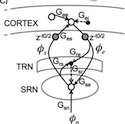Abstract
Meditation training has been shown to enhance attention and improve emotion regulation. However, the brain processes associated with such training are poorly understood and a computational modeling framework is lacking. Modeling approaches that can realistically simulate neurophysiological data while conforming to basic anatomical and physiological constraints can provide a unique opportunity to generate concrete and testable hypotheses about the mechanisms supporting complex cognitive tasks such as meditation. Here we applied the mean-field computational modeling approach using the scalp-recorded electroencephalogram (EEG) collected at three assessment points from meditating participants during two separate 3-month-long shamatha meditation retreats. We modeled cortical, corticothalamic, and intrathalamic interactions to generate a simulation of EEG signals recorded across the scalp. We also present two novel extensions to the mean-field approach that allow for: (a) non-parametric analysis of changes in model parameter values across all channels and assessments; and (b) examination of variation in modeled thalamic reticular nucleus (TRN) connectivity over the retreat period. After successfully fitting whole-brain EEG data across three assessment points within each retreat, two model parameters were found to replicably change across both meditation retreats. First, after training, we observed an increased temporal delay between modeled cortical and thalamic cells. This increase provides a putative neural mechanism for a previously observed reduction in individual alpha frequency in these same participants. Second, we found decreased inhibitory connection strength between the TRN and secondary relay nuclei (SRN) of the modeled thalamus after training. This reduction in inhibitory strength was found to be associated with increased dynamical stability of the model. Altogether, this paper presents the first computational approach, taking core aspects of physiology and anatomy into account, to formally model brain processes associated with intensive meditation training. The observed changes in model parameters inform theoretical accounts of attention training through meditation, and may motivate future study on the use of meditation in a variety of clinical populations.
